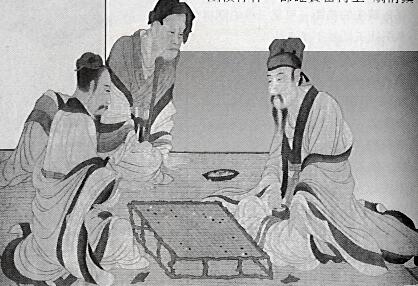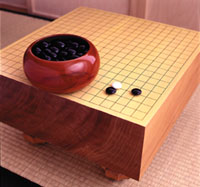After its
start in China, go spread throughout East Asia, ending up as major parts
of the cultures of Japan and Korea as well as China. The growth of
the game took different roads in each country, with rules and its place
in culture changing over time.
 China
is the obvious place to start, as the game first developed here and has
had the longest time to be a part of the culture. Some of the earlier
definite references to Go can be seen in the works of Confucius. He makes
mention of it in an unflattering manner, causing future generations to
at times regard Go as un-Confucian. Later it begins being known as
a game of skill and those who are good at it tend to be known as wise men. China
is the obvious place to start, as the game first developed here and has
had the longest time to be a part of the culture. Some of the earlier
definite references to Go can be seen in the works of Confucius. He makes
mention of it in an unflattering manner, causing future generations to
at times regard Go as un-Confucian. Later it begins being known as
a game of skill and those who are good at it tend to be known as wise men.
At this period
in time it appears that the game was played on 17x17 boards rather then
the 19x19 boards used today. It is unclear when and why the change
occurred, but there is evidence that they were both in use for some time
together before 19x19 boards became the general type used. For example
in Tibetan Go a 17x17 board is still used today, making it seem obvious
the switch to 19x19 boards was not universal.
Another difference
that existed in early Chinese Go was the concept of placement. In
placement, four stones are placed on the board before play, black stones
diagonal corner star points and white stones on the other diagonal corner
star points. This would end up limiting Chinese Go players as other
countries had gotten rid of that rule and allowed for more inventive openings
that led to all sorts of new strategies. By the time placement was
gotten rid of in China, they lagged far behind other countries. Eventually
the “Chinese” opening was developed as it was one the other countries had
not seen before and could help keep Chinese players on even ground to continue
the game.
In China today
there are many top world players living there or that have come from there.
The top women's player in the world, Rui Naiwei, is from China and was
the first woman ever to win a major open title. Other pro players from
China consistently play well against international competition, not quite
as well overall as the Korean players, but better overall then Japanese
players.
The next country
to look at is Korea. As in other countries, the game began as something
for the aristocracy. It was seen as a romantic pursuit for the scholarly
and wise.
In 1592 after
the Japanese invaded Korea, Go began to be popular among the middle class
as still one of the important arts all wise and scholarly people were good
at. It was played by many a commanding officer Korea during the conflict
with Japan. This style of Go was still the old style brought from
China many hundreds of years before but a new style was developed, Sun
Jang Baduk. In this style 16 stones are first placed on the board
and then with the first move by black is placed on tengen, the center star
point. This style forced fighting in the early game and made many
Korean plays very adept at dealing with any situation that could arise
in the game.
After World
War II, Go began the rise to prominence it holds today in Korea.
A professional institute was established and pro games began to be played.
Players emerged with great strength and understanding of the game.
When international tournaments began to be held Korea would often come
out on top. In the 90’s Korea became the undisputed top Go power
in the world. Many titles were consistently held by the top Korean
players and still are today. Also the person considered the strongest
player in the world is Korean, Lee Chang-Ho.
Finally we
look at Go in Japan. After it had spread to the country in the 8th century
the next period of real interest in Japanese Go history isn't until the
Tokugawa Shogunate period.
Before this
time, there would often be Go tutors who worked specifically for the emperor,
the best players in the country with the sole purpose of teaching the emperor
to play better. When the first Tokugawa Shogun came into power he established
an official government post for the best player in the country to be personal
tutor to the shogun, the Meijin Godokoro. A highly coveted position, the
Meijin Godokoro had power, prestige, and also a direct line to the shogun.
Go support
by the shogun didn't stop there. In 1612 the government began subsidizing
the four major Go houses at that time: the Honinbo, Inoue, Hayashi, and
Yasui. For the next 250 years these schools were supported by the government
until the Meiji Restoration brought their funding to an end.
Also at this
time the castle games were started. A castle game is a Go game between
two of the best players around, usually from the heads or upper ranks of
the four schools, played before the shogun at his castle. The first one
was held in 1605, but it wasn't until 1628 that it was made an official
ceremony and after 1667 they began to be held annually. The most famous
participant of these castle games is Honinbo Shusaku, who in nineteen consecutive
castle games never lost once. The castle games also suffered when the Meiji
Restoration came about, they were never held again after 1863.
With all the
turmoil in Japanese Go during the Meiji Restoration, game play around the
country suffered a great deal. This was one of the low periods of Go in
the country until newspapers began to help sponsor it. Newspapers would
publish weekly Go columns, discussing games and strategy and giving the
average person an easy look into the world of professional Go. As years
went on newspapers began to sponsor tournaments, and today all the major
tournaments in Japan are supported by newspapers.
Japanese Go
also benefited by the creation of the Nihon Kiin in 1924. The Nihon Kiin
is the main Go body in Japan; it organizes professional events and handles
rank promotions and such. The last head of the Honinbo school helped to
establish the Nihon Kiin by handing over the title of Honinbo to be determined
by tournament through the organization. Today all titles are determined
through tournaments in this way.
Go in Japan
today is suffering. Constantly behind other Go powers China and Korea in
international play, Japan is searching for a way to retake its place as
the top Go power in the world. Help is coming from a strange place these
days, anime and manga. Hikaru No Go is the story of a boy named Hikaru
and the ghost of a Heian period Go tutor to the emperor named Sai. The
two are forced together when Hikaru finds the ancient Go board the ghost
is trapped inside in his grandfather?x2019;s attic. Hikaru then begins
to learn to play and enjoy Go from Sai and quickly becomes a great player.
The popularity of the manga led it to being made into an anime that is
equally as popular. Due to this new phenomenon Go has had resurgence among
the young in Japan, with classes for children quickly filling up and new
classes starting all around. This will hopefully bring about many new great
players to help Japan reach the top of the Go world again.
|
 The
Japanese board game of Go, known in China as Wei Qi and Korea as Baduk,
is an ancient game of strategy played thougought most of East Asia. As
it spread from China to Korea and Japan, the game developed and grew in
each. All developing their own styles and ways of playing, the game today
is quite international and those three countries regularly compete to see
who is the strongest.
The
Japanese board game of Go, known in China as Wei Qi and Korea as Baduk,
is an ancient game of strategy played thougought most of East Asia. As
it spread from China to Korea and Japan, the game developed and grew in
each. All developing their own styles and ways of playing, the game today
is quite international and those three countries regularly compete to see
who is the strongest.
 China
is the obvious place to start, as the game first developed here and has
had the longest time to be a part of the culture. Some of the earlier
definite references to Go can be seen in the works of Confucius. He makes
mention of it in an unflattering manner, causing future generations to
at times regard Go as un-Confucian. Later it begins being known as
a game of skill and those who are good at it tend to be known as wise men.
China
is the obvious place to start, as the game first developed here and has
had the longest time to be a part of the culture. Some of the earlier
definite references to Go can be seen in the works of Confucius. He makes
mention of it in an unflattering manner, causing future generations to
at times regard Go as un-Confucian. Later it begins being known as
a game of skill and those who are good at it tend to be known as wise men.